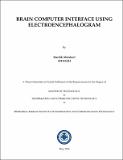| dc.description.abstract | Brain Computer Interface (BCI) provides a pathway for communication from humansto computer without any muscular activity. Common Spatial Pattern (CSP)algorithm has been proved to be effective in Brain Computer Interface (BCI) forextracting features from Electroencephalogram (EEG) signals used in motor imagerytasks. However, CSP is vulnerable to noise and also prone to overfitting.Traditionally, CSP is used for classification of two class problems and therefore,many algorithms have been devised to regularize CSP for two class problem.When these algorithms were extended to multiclass, they have not proved to beeffective. We propose a method to remove trials that are affected by noise beforecalculating the CSP. This helps in calculating eigenvectors which generates betterCSP, and better spatial filter which is more closer to the generic features of thatclass. The EEG signals are non-stationary in nature, which pose a challenge is classificationafter features are extracted. To handle the non-stationarity in the EEGsignal, Type-2 neuro fuzzy sets have been found to be effective. Self-RegulatedInterval Type-2 Neuro-Fuzzy Inference System (SRIT2NFIS) is built upon type-2fuzzy sets, which handles the non-stationarity as a uncertainty measure and hasless computational complexity compared to traditional Type-2 neuro fuzzy systems.SRIT2NFIS for two class CSP with Tikhonov regularization for EEG datafor BCI has been proven effective. This thesis extends the SRIT2NFIS to MulticlassCSP using Joint Approximate Diagonalization (JAD) for Multiclass and CSPand Mutual information based feature extraction. While implementing BCI ina practical scenario, response time of a system and misclassification rate in themotor imagery task can be very fatiguing to the users. To address this concern,we propose two modification in the classification paradigm, an additional classwhich is termed as rest/idle class for reducing misclassification and predictingoutput in the testing phase by using half of the time samples, while keeping trainingmethod intact to reduce the response time of the system. The results are presentedfor standard dataset. | |

